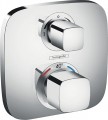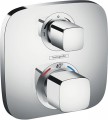Suitable for
Types of application provided by the design of the tap.
Modern taps can be designed
for bath,
shower,
washbasin,
bidet,
kitchen,
drinking water filter only and with the possibility of
connecting to a filter. At the same time, many models are designed for several application formats at the same time — for example, functioning with a bathtub and a washbasin at the same time; and there are models
without mixing water at all (with one connection pipe) — only for cold or only for already mixed water. More details in the separate paragraphs below.
— For bathtub. Taps used to fill the bathtub. Traditionally provided for wall mounting (see "Installation"), although there are exceptions in some specific models. In addition to a bathtub, such a tap can be used for a shower and/or a washbasin; in the first case, the design provides for the connection of a shower set, in the second, a long swivel spout that can be turned from the bathroom to the sink of the nearby washbasin.
— For shower. This option means that a shower set can be connected to the tap; sometimes such units are even supplied as a set (see "Spout design"). Specialized shower taps are exclusively wall-mounted or built-in (see "Install
...ation"). At the same time, in addition to “shower-only” models, there are also “multi-purpose” products designed to be used simultaneously with a bathtub, and sometimes also with a washbasin (see “For bathtub” above).
— For washbasin. Specialized taps designed only for washbasins and have a relatively short spout, usually fixed, and can be installed in almost any way (except that floor models are a rather exotic option that has not gained distribution). Due to the similarity of washbasins with kitchen sinks, some models of a similar design can also be used as kitchen taps. Another, quite common, option is a hygienic shower for use with a bidet. Also note that the “washbasin” assignment can also be provided as an additional function in taps originally designed for bathtubs (see above).
— For kitchen. Taps for this purpose can be both highly specialized and provide other applications — for a washbasin (see above) or for a drinking water filter (see below). Anyway, such products are mounted mainly on a wall or tabletop, and the spout can be made quite high so that a pan or other large dish can be placed under. Also, in kitchen taps an interesting feature as a spring spout can be found (see "Spout design").
— For bidet. A bidet is a device in the form of a hygienic bath for washing the external genitalia and anus after going to the toilet. The classic bidet tap is installed directly on such a bath in a horizontal way (see "Installation"); the shape and design of the spout in such models is selected in such a way as to ensure effective ablution. However, in addition to this, the “bidet” category also includes specialized taps for a hygienic shower — a similar procedure carried out using a separate shower set. Such taps are built into the wall and do not require a separate bidet — a hygienic shower can also be used with a conventional toilet.
— For drinking water filter. Taps designed to supply drinking water from a tap filter, usually located under the kitchen sink. They are installed exclusively on the tabletop (see "Installation"), most often on the sink itself. Specialized models with only this equipment are distinguished by their small size and single-valve design (see "Tap type"). In addition, the possibility of connecting a drinking water filter can be provided as an additional feature in kitchen taps (see above). In such models, the spout has two holes — for "common kitchen" and for drinking water; each flow is controlled separately by its own valve (set of valves) or by a joystick.
— No water mixing. Taps that are designed to supply water at the still temperature. Outwardly, such models are no different from the classic ones: some are made with levers, others with a cross handle. But the key to them is the presence of only one pipe for supplying water. Accordingly, you can connect only cold, only hot or already mixed water.Diverter
A diverter is a device that switches a water flow between spout and shower head. The design of such a device and the way it is controlled can be different, in modern taps you can mainly find the following options:
— Button. Diverters of this type have the form of a button; but its design depends on the characteristics of a particular tap. In relatively simple mechanical models (most of them), the button is also made mechanical, and to switch from spout to shower, you need to pull it up. And switching in the opposite direction — from a shower to a spout — can often be carried out not only manually, but also automatically, when the water is turned off (see "Features — Shower / bath auto switch"). In some taps, auto-switching can also be blocked by the user (usually by turning the button in the up position).
In turn, in advanced electronic devices, such a diverter is made in the form of an electric button that closes the contacts that control the valve.
— Lever. Diverter in the form of a rotary lever. Most often, this lever directly controls the valve that switches the flow of water. This design is considered somewhat less reliable than push-button, but it is much simpler and cheaper, which makes it very popular — especially in relatively inexpensive taps. But in premium devices, this type of diverter can operate according to other, more advanced principles — for example, a lever can work as an electronic switch.
— Turning the spout. A r...ather rare and specific option: the role of the lever that controls the flow of water is performed directly by the spout, to the base of which a shower hose is connected. Such a control, usually, works as follows: while the spout is perpendicular to the tap body, water flows through it, and to switch to the shower, the spout turns, being under the tap. Such devices look interesting, and are convenient to use. On the other hand, they are quite complex and expensive, and the spout itself, for a number of reasons, is typically made quite short. Therefore, this variant has not gained popularity.
— Removable. A diverter located outside the body — usually between the tap itself and the spout. Typically, on one side of such a device there is a control element (most often a small lever or a rotary tap), and on the other, a pipe for connecting a shower hose. And the name "removable" suggests that this part can be easily removed if needed — unlike, for example, push-button or lever solutions, which are usually built directly into the tap body and are very difficult to dismantle or replace. Accordingly, after removal, the diverter can either be replaced with another one, or removed altogether by connecting the spout directly to the tap. This is the main advantage of this option: in case of malfunctions in the diverter, it can be removed without any problems for repair or replacement, while the tap (with the exception of the “shower part”) remains fully operational.
Country of brand origin
Country of origin of the brand under which the tap is marketed. Usually, it is indicated by the "homeland" of the manufacturing company or by the location of its headquarters. The brands under which modern mixers are produced come mainly from the following countries (in alphabetical order):
Austria,
Belgium,
Germany,
India,
Spain,
Italy,
China,
Poland,
Russia,
Turkey,
Czech Republic,
Finland,
France,
Sweden.
There are many stereotypes associated with the “nationality” of brands and products, but most of them have no basis nowadays. First, the actual place of production is often different from the brand's country of origin. Secondly, the quality of the goods depends not so much on geography, but on the policy of a particular company and how carefully this very quality is controlled in it. Therefore, you should pay attention to the country of origin of the brand only if you fundamentally want or (do not want) to support a manufacturer from a certain state. Quality is best judged by the reputation of a particular
...brand and the overall price category of the tap.
